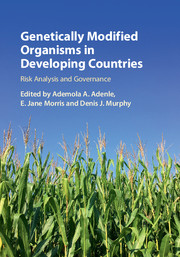Book contents
- Genetically Modified Organisms in Developing CountriesRisk Analysis and Governance
- Genetically Modified Organisms in Developing Countries
- Copyright page
- Contents
- Contributors
- Foreword
- 1 Introduction
- Part I Risk Analysis Methodology and Decision-Making
- Part II Diversification of Expertise
- 8 Regulation of GMOs in Developing Countries: Why Socio-Economic Considerations Matter for Decision-Making
- 9 Food Safety Assessment of Genetically Modified Crops in Developing Countries: The Experience in Africa
- 10 Being Scientific about Socio-Economics in GMO Decision-Making in Developing Countries
- 11 The Sharing of Information in Risk Assessment: How National Authorities Cooperate
- 12 Should GM Rice with Nutrition Benefits Be Deployed? Findings from Biotech and Socio-Economic Research
- Part III Risk-Analysis-Based Regulatory Systems
- Part IV Case Studies from Developing Countries
- Index
- References
9 - Food Safety Assessment of Genetically Modified Crops in Developing Countries: The Experience in Africa
from Part II - Diversification of Expertise
Published online by Cambridge University Press: 05 July 2017
- Genetically Modified Organisms in Developing CountriesRisk Analysis and Governance
- Genetically Modified Organisms in Developing Countries
- Copyright page
- Contents
- Contributors
- Foreword
- 1 Introduction
- Part I Risk Analysis Methodology and Decision-Making
- Part II Diversification of Expertise
- 8 Regulation of GMOs in Developing Countries: Why Socio-Economic Considerations Matter for Decision-Making
- 9 Food Safety Assessment of Genetically Modified Crops in Developing Countries: The Experience in Africa
- 10 Being Scientific about Socio-Economics in GMO Decision-Making in Developing Countries
- 11 The Sharing of Information in Risk Assessment: How National Authorities Cooperate
- 12 Should GM Rice with Nutrition Benefits Be Deployed? Findings from Biotech and Socio-Economic Research
- Part III Risk-Analysis-Based Regulatory Systems
- Part IV Case Studies from Developing Countries
- Index
- References
Summary
- Type
- Chapter
- Information
- Genetically Modified Organisms in Developing CountriesRisk Analysis and Governance, pp. 103 - 114Publisher: Cambridge University PressPrint publication year: 2017



